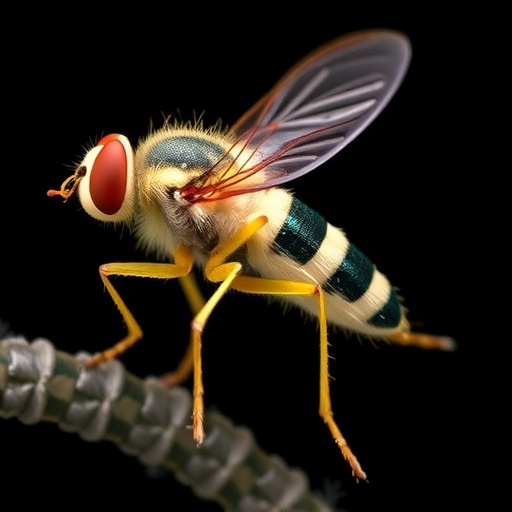In a groundbreaking study published in 2025, researchers have taken a significant leap forward in the taxonomic understanding of the finch louse fly, Ornithomya fringillina (Curtis), a member of the parasitic Hippoboscidae family. This fly, known for its specialization in infesting finch hosts, represents a complex taxonomic puzzle that has long puzzled entomologists and parasitologists alike. The new research, led by Wawman, Bailey, and Fiddaman, employs detailed morphological analysis combined with cutting-edge molecular techniques to untangle the web of variation within this species, offering fresh insights into its evolutionary biology and host-parasite dynamics.
The researchers initiated their study by collecting specimens from a variety of finch species across multiple geographic regions. This expansive sampling strategy was critical to capture the full spectrum of morphological diversity present in O. fringillina populations. By examining fine structural features such as wing venation patterns, leg morphology, and the structure of specialized bristles, the team sought to discern subtle morphotypes that might represent cryptic species or intraspecific variants. These traditional morphological assessments were simultaneously supplemented by DNA sequencing of mitochondrial and nuclear gene regions known to provide robust phylogenetic signals.
.adsslot_0CqNmgSsTG{ width:728px !important; height:90px !important; }
@media (max-width:1199px) { .adsslot_0CqNmgSsTG{ width:468px !important; height:60px !important; } }
@media (max-width:767px) { .adsslot_0CqNmgSsTG{ width:320px !important; height:50px !important; } }
ADVERTISEMENT
Furthermore, the study sheds light on the evolutionary processes driving diversification within O. fringillina. The morphological and genetic data combined indicate that host specificity and geographic isolation are likely key factors fueling speciation events. For instance, populations associated with different finch hosts or inhabiting distinct ecological niches showed patterns of reproductive isolation and genetic structuring, supporting the hypothesis that coevolution between parasite and host plays a pivotal role in shaping parasite diversity.
This research does not only refine the taxonomy of O. fringillina but also introduces a methodological blueprint for tackling similar challenges in other parasitic fly taxa. The integrated approach combining morphometric techniques with molecular systematics has proven indispensable in revealing hidden diversity and ensuring taxonomic accuracy. In light of these findings, the authors advocate for a revision of diagnostic keys used in Hippoboscidae identification, emphasizing the need to incorporate molecular data to supplement traditional morphological criteria.
The implications of this study extend to the broader field of parasitology, highlighting the complex interplay between morphology, genetics, and ecology in parasite evolution. The existence of morphotypes with overlapping characteristics but divergent genetic backgrounds underscores the limitations of relying solely on external traits for species delimitation. This insight urges the scientific community to adopt multifaceted approaches in taxonomic investigations, especially for organisms exhibiting cryptic speciation.
The authors further discuss how this research can catalyze future inquiries into the coevolutionary arms race between finches and their louse flies. Given the intricate dependencies between host and parasite, evolutionary pressures likely drive rapid divergence in parasite traits, some of which may be only detectable at the genetic level. This ongoing dialogue between morphological and molecular evolution presents a fertile ground for experimental work aiming to decipher the mechanisms underpinning speciation in parasitic insects.
Importantly, the study underscores the necessity of international collaboration and comprehensive sampling when addressing taxonomic enigmas. By pooling expertise across disciplines and geographic locations, the researchers were able to assemble a robust dataset reflective of O. fringillina’s diversity, a feat that localized studies often fail to achieve. This collaborative spirit not only enriches the quality of scientific outputs but also promotes standardization in taxonomic protocols that benefit the global research community.
As the scientific exploration of parasitic flies advances, studies like this serve as exemplars of how integrative taxonomy can unlock hidden layers of biodiversity. By intricately merging traditional morphological scrutiny with modern genetic methodologies, these researchers have charted a course toward a more accurate, comprehensive understanding of parasite diversity—a foundational prerequisite for effective wildlife management and disease control. The knowledge gained herein thus resonates beyond academic circles, offering critical insights into the delicate balance between hosts and their obligate parasites.
This landmark paper ultimately redefines our conception of Ornithomya fringillina by revealing its hidden complexity, inviting researchers to rethink classifications within Hippoboscidae and prompting fresh considerations of host-parasite coevolutionary processes. The study stands poised to inspire further investigations that leverage both phenotypic and genotypic data to illuminate the fascinating biodiversity residing within the small yet impactful world of parasite flies.
Subject of Research: Taxonomic clarification and morphotypic analysis of the finch louse fly Ornithomya fringillina (Curtis), with implications for parasite biodiversity and host-parasite interactions in Hippoboscidae.
Article Title: Clarifying the Taxonomy of the Finch Louse Fly Ornithomya Fringillina (Curtis) (Diptera: Hippoboscidae) – An Analysis of Morphotypes
Article References:
Wawman, D.C., Bailey, A.S., Fiddaman, S.R. et al. Clarifying the Taxonomy of the Finch Louse Fly Ornithomya Fringillina (Curtis) (Diptera: Hippoboscidae) – An Analysis of Morphotypes. Acta Parasit. 70, 175 (2025). https://doi.org/10.1007/s11686-025-01113-z
Image Credits: AI Generated
Tags: avian ectoparasites researchecological importance of louse fliesfinch host specificityfinch louse fly taxonomyHippoboscidae family characteristicshost-parasite interactionsmolecular techniques in taxonomymorphological analysis techniquesOrnithomya fringillina morphologyparasitic fly evolutiontaxonomic challenges in entomologyvariation in insect morphology





